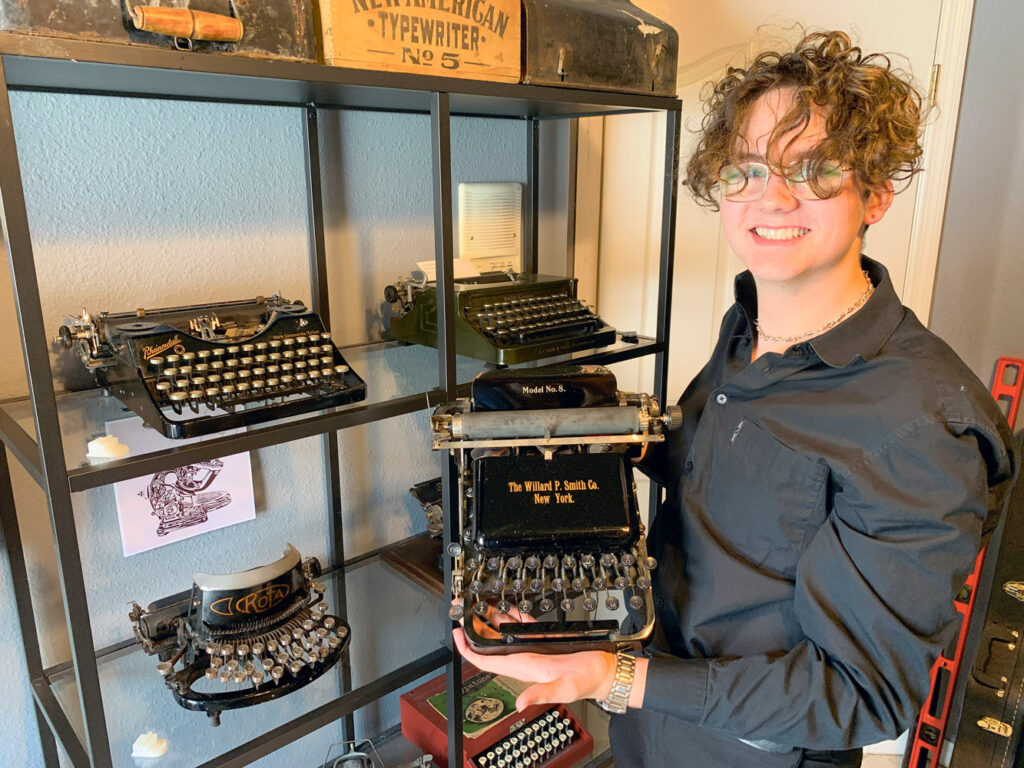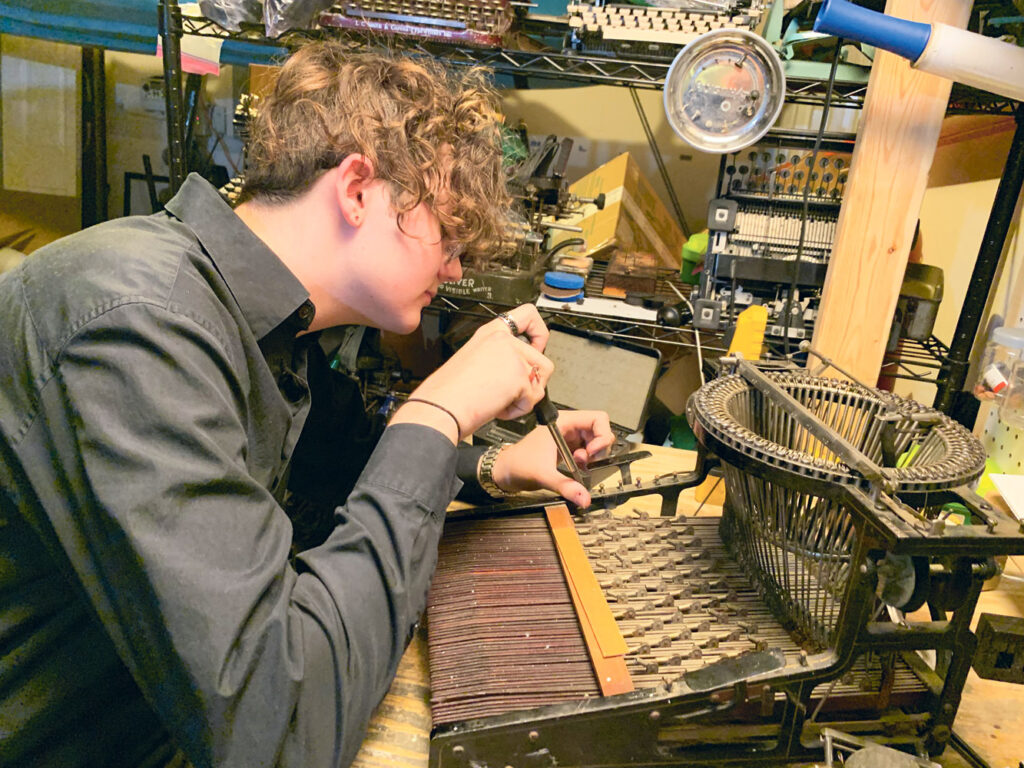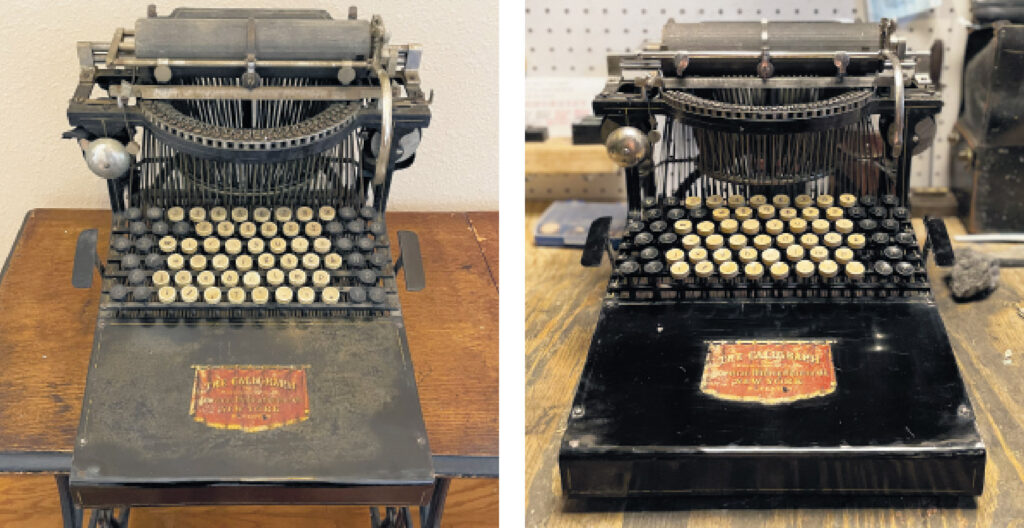
Like most kids his age, 16-year-old Jack Armstrong can sit in front of a keyboard for hours on end, expertly manipulating the keys with his fingers to get the desired result.
There is one major difference, however. Instead of doing so in front of a computer, Armstrong is sitting in front of an actual typewriter, which are sometimes 100 years older than he is.
Whether it’s an 1880s Caligraph 2, a 1907 Handler or a 1914 Annell, Armstrong takes great delight in dissecting these machines from another time and restoring them to their original working condition, which he then sells, trades or displays on a shelf in his bedroom.
“It’s a passion,” he says of his craftsmanship. “I just love it.”
Armstrong is a rarity in the world of typewriter collectors and repairs, due to his age, but he is far from alone. He estimates that there are roughly 5,000-6,000 typewriter enthusiasts across the country who gather at small conventions and actively collect, trade and sell machines that may be outdated, but still stoke a deep love and appreciation from their admirers.
Armstrong has loved typewriters since he was a young kid, when his mother Rebecca would drag him with her on her Saturday afternoon antiquing expeditions.
Always a mechanical sort with a knack for taking things apart to see how they work, Armstrong was always drawn to the old typewriters he would see, with so many gears and type bars.
He was 12 when he asked for one for Christmas, and his parents bought him a 1949 Royal. It needed repairs, so he found some tips on YouTube and, an hour later, the Royal was back in service.
“I was able to take this old antique that didn’t work and make it like new,” Armstrong says. “I got addicted to that, and it’s been snowballing ever since.”
An online high school student who is practically on the computer 24/7, Armstrong says he finds the tactile experience and ability to disconnect while he types refreshing and necessary. He types and mails 3-4 letters a week to friends and other collectors.
And Armstrong has turned his passion into a business— the Tampa Typewriter Co. People from around the world now send him their typewriters, paying — and praying — for a miracle restoration.
He says he made $20 on his first repair job, though that same job would cost $100 now. His slogan: “I can repair any typewriter from 1880 to 1980.”
“It just clicked at that moment that I’ve tapped into a niche,” Armstrong says. “I can turn this into a genuine business.”

While others may just paint or spruce up older typewriters for customers who want a display piece, Armstrong says he tries to keep the original finish, even if that means a good helping of elbow grease. He will source the parts and replace things like the felt soundproofing, the rubber feet and everything in between.
“What I focus on is making them work,” he says. “I make them as nice as possible, and as new as possible.”
That means zero short cuts, which might include polishing a part of the typewriter that you will never see again. “I shine it up to a mirror finish, even though you won’t see it unless you take the machine apart.”
Armstrong’s latest effort was restoring an 1890 Caligraph No. 2 with a matching table. He put in more than 25 hours on the project, and has it listed for $2,000 on tampatypewriter.com. He wouldn’t hate keeping it as his own, either.
So Many Stories…
In his Wesley Chapel home, which includes a workshop in his garage, Armstrong has roughly 100 typewriters — 80 are his, and the other 20 he is repairing.
Typewriters that still work are rare. Of the 100 or so he says he has purchased via eBay over the years, only three arrived without needing anything more than a new ribbon.

He’s always looking. The one typewriter he would like to own? A Commercial Visible 6, a sleek silver machine with a gold decal that uses a type wheel that can be switched with another to change the font.
It originally sold for $50 in 1898. Armstrong says only 35 are known to still exist.
“It’s one of the most beautiful typewriters ever produced,” Armstrong says.
His most valuable typewriter is a Willard P. Smith Co. Armstrong says everything he has can be had for a price, but the Willard P. Smith would require a hefty bounty.
He won the typewriter in an auction on eBay, bribing other bidders to bow out. It cost him $800 total.
“No typewriter has ever sold for over a million dollars. But, I would need over a million dollars (to sell the Willard P. Smith),” Armstrong says. “It’s just too special to me.”
Armstrong’s prized possession, however, is an Armstrong typewriter, which he wanted because of the shared name. There are only 14 in existence, and he owns two of them.
“They are my obsession,” he says, and they share a shelf with the Willard P. Smith in his room, which he refers to as his own personal typewriter museum.
When it comes to actual museums, Armstrong will soon have some of his own handiwork on display in one. A few typewriters that he restored for collectors Mark and Christina Albrecht of Bradenton were bought as part of a larger collection for a soon-to-be-built museum in Dubai, “which is pretty cool,” Armstrong says.
Every typewriter in his room has a story, and Armstrong revels in telling them. There’s the Type-a-Tune, a 1949 machine used to teach typing that also plays music, and he was offered $800 just for the instructional book alone.
A Simplex typewriter has attracted offers of more than $5,000, and a Vogue Royal with a sans serif typeface will sell for roughly $3,500. A rusty Annell is one of only 11 known to exist and has a pharmaceutical keyboard, as well as a sans serif typeface, making it even rarer, while his Mignon Model 2B has a Blackletter typeface called Fraktur. The typewriter was produced during a time when the Fraktur typeface was obsolete and not used, he says.
Thanks to some recent media exposure, Tampa Typewriter Co. is growing. Armstrong has restored nearly 250 typewriters, and as word of his dedication and prowess spreads, more business keeps coming his way. He has made more than $50,000 in sales to date, and says he would one day like to open a physical location.
Typewriters themselves may be obsolete, but this Wesley Chapel teenager is working hard to keep them alive.
“I’m 16, and I think people like the idea of this young gun working on these old machines,” Armstrong says. “It’s an unmatched level of work, and I just have this insane passion for it that most people don’t.”
For typewriter repairs, refurbs and resales, or just to check out some of the many collectibles Armstrong has repaired, visit TampaTypewriter.com, send an email to Tampatypewriter@gmail.com or call (813) 992-9799.




No comment yet, add your voice below!